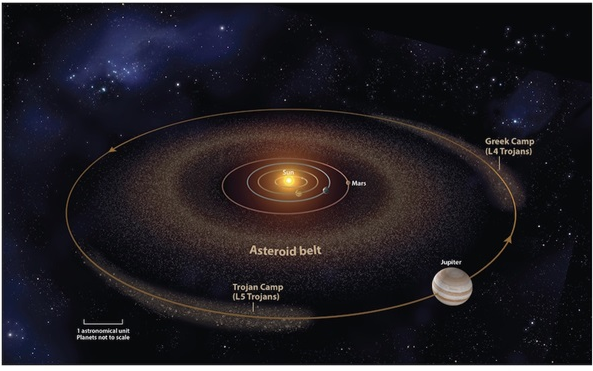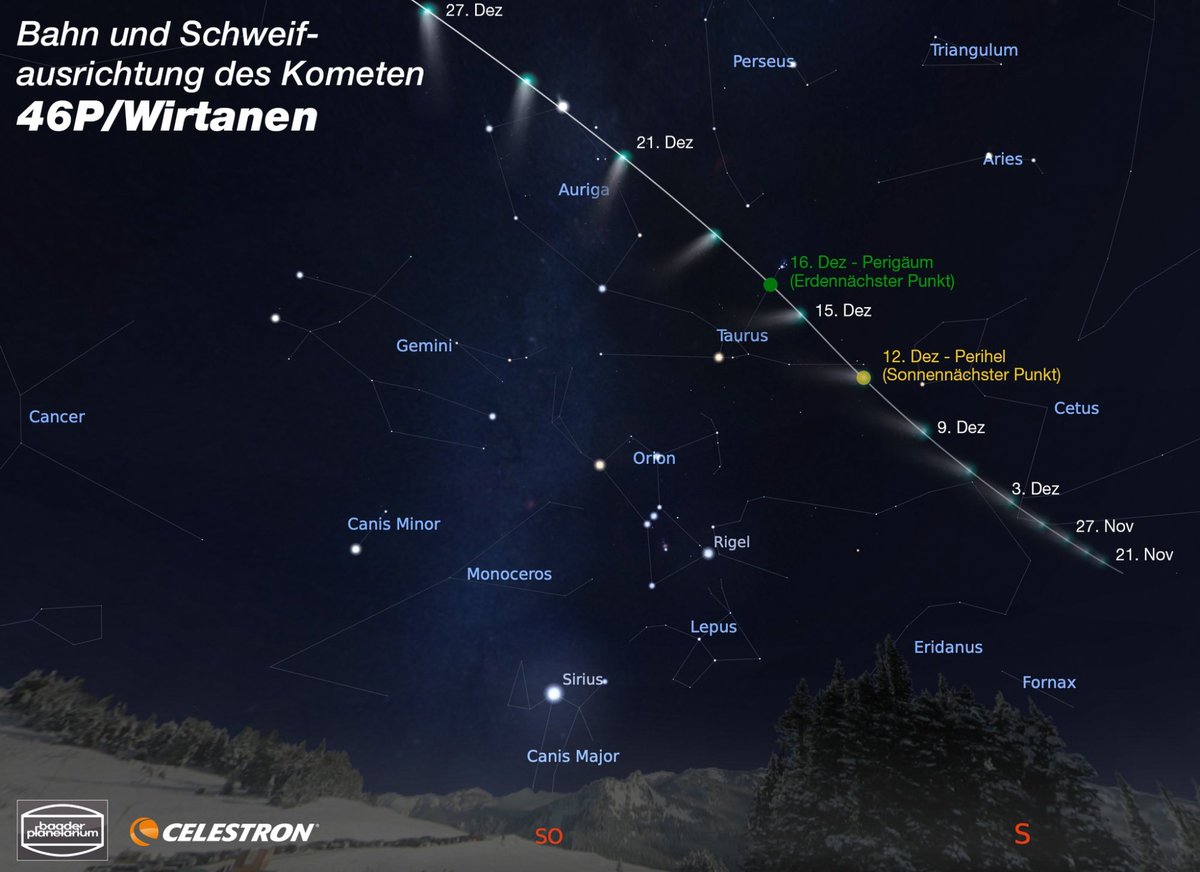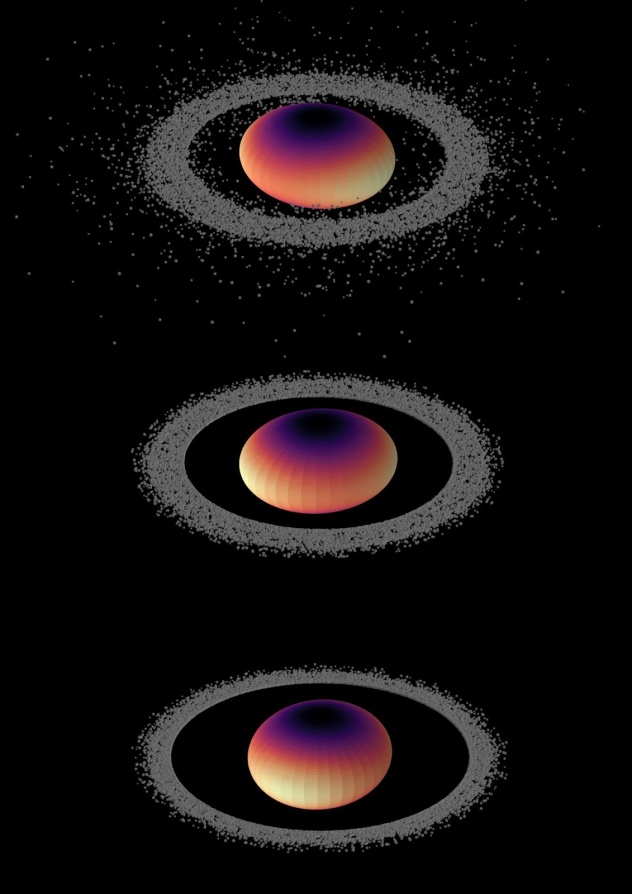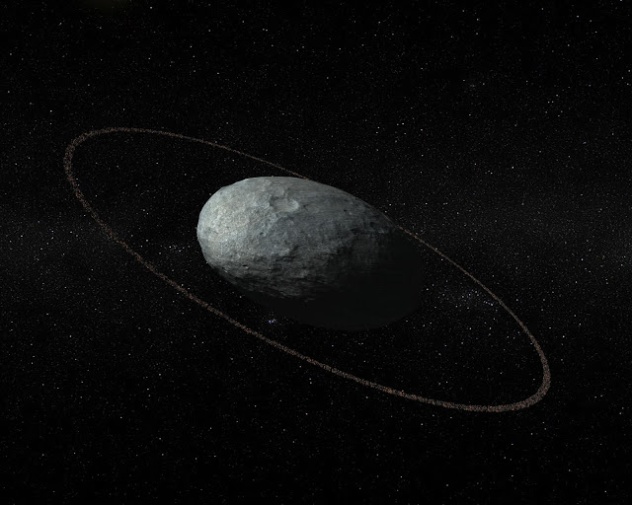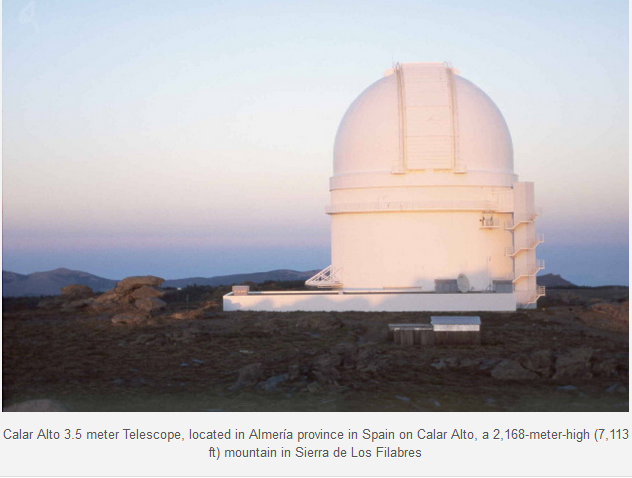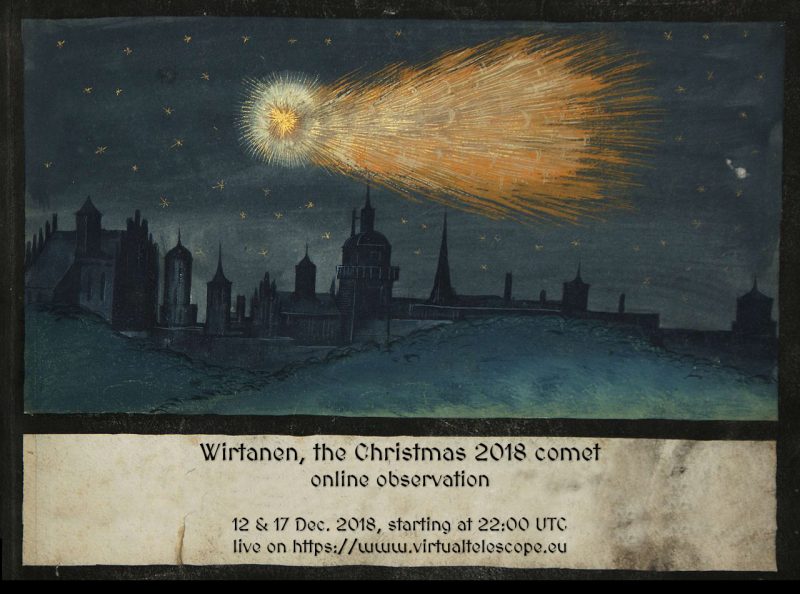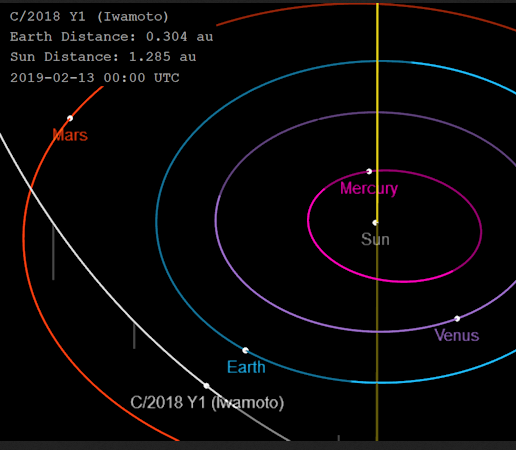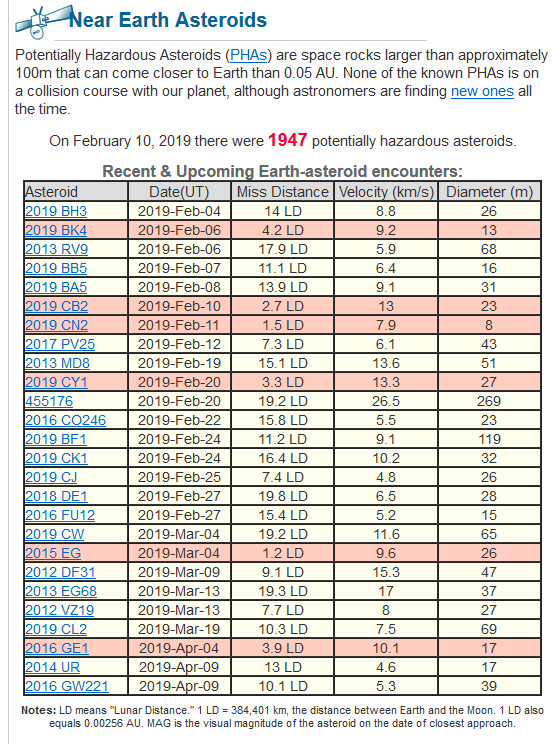Translated from Spanish by
Microsoft
Above the constellation of the oven approaching each day to the Taurus, does not come out in Stellarium

I hope this image will serve you.
From Instituto de Astrofísica de Andalucía, IAA-CSIC via Manu Garcia of IAC: “The complex dynamics of the ring systems miniature solar system”
richardmitnick 8:50 pm on November 21, 2018
From Manu Garcia, a friend from IAC.
Ring systems around small celestial bodies.
Result of a numerical integration showing the development of seven hundred particles orbiting an elongated body size and shape similar to Chariclo (an ellipsoid with the major axes of 314 x 278 x 172 kilometers). The particles are subject to a radial dissipative force that simulates the effect of collisions. After three months (upper panel), most of the particles within the corotación (190 kilometers from the center of Chariclo) fell on the body. After a year (central panel), it has been emptied the internal area, and after a year (lower panel) particles continue their migration to the outer areas.
The discovery of rings around the Solar System bodies that are not planets, like the dwarf planet Haumea or centaur Chariclo, showed that it is most common structures than previously thought. Work in the Institute of Astrophysics of Andalusia (IAA-CSIC) participates, analyzes the complex dynamics of these rings in miniature.
Until five years ago it was thought that the rings were unique features of large gaseous planets, like Saturn or Uranus, but the discovery of rings around no planetary bodies in the solar system forced to review these structures, apparently more common than is I thought. Now, a job in which the Institute of Astrophysics of Andalusia (IAA-CSIC) participates has analyzed the dynamics of these ring systems in miniature, more complex in some cases than the giant planets because of the terrain or elongated shape of these bodies.
In 2013 and 2017, respectively, two bodies of the solar system entered the small group of objects ring: Chariclo, the largest of a population of objects known as centaur, which are among Jupiter and Neptune and share features with both comets as asteroids; and Haumea, a dwarf planet beyond Neptune with ellipsoidal shape and size, most side, similar to Pluto.
The complex dynamics of the ring systems miniature solar system. Image author transneptunian object Haumea.
Both have narrow and confined rings, suggesting the existence of “satellites shepherds” that contribute to the rings remain confined as those seen around Saturn and Uranus. However, there is an important difference between giant planets and no planetary bodies, since the latter can show very irregular shapes: may have reliefs such as craters or mountains, nonexistent in the gaseous planets, or show an elongated shape (Haumea, for example, it has a flattened shape as a rugby ball).
“In this study we showed that these deformations or irregularities create gravitational resonances between the body and the ring particles that cause synchronous orbit (or corotation), wherein the particles have an orbital period equal to the rotation of the central body, is empty: the particles of the disc that are within the corotation fall toward the central object and, conversely, that are outside are pushed outward beyond the 1: 2 resonance (in which complete a revolution around the body at the time this tour twice on itself), “said Pablo Santos-Sanz, researcher at the Institute of Astrophysics of Andalusia (IAA-CSIC), which participates in the work.
The time scales associated with the migration of the particles of the disk are small, a few years in the case of elongated bodies, as Haumea. For a spherical body with an equatorial mountain five kilometers, the area co-rotation can be emptied in less than a million years, a period of very short time compared to the age of the Solar System.
These findings are confirmed in the known objects: rings Chariclo and Haumea are four hundred and two thousand two hundred and ninety kilometers outside its resonances 1: 2, which occur three hundred and fifty kilometers respectively seven hundred thou.
Another prediction paper presented affects the rotation of the body, to be rotated very quickly on itself so that the particles at that distance are kept forming a stable ring or, otherwise, would vent further, to finish perhaps forming satellites . For frozen bodies as Chariclo and Haumea rotation period must be less than seven hours, which is also true, and rotating on themselves seven and four hours, respectively.
“This is a field still new study because five years ago we did not know that these objects could present rings. These mechanisms could also explain the formation of satellites around certain bodies through the migration of a disk initially more next to the object, “says Pablo Santos-Sanz (IAA-CSIC).
Science paper:
Ring around non-axisymmetric dynamics with application to Chariklo bodies and Haumea
Nature Astronomy
See the full article
here.
Welcome
Welcome to the
Instituto de Astrofísica de Andalucía (IAA). The IAA is an institute of Consejo Superior de Investigaciones Científicas (CSIC) in Granada – Andalucía. The activities of the IAA (CSIC) are related to research in the field of Astrophysics and the development of instruments for telescopes and space vehicles.
These webpages are intended to present our activities as well as useful information both for other professional institutions devoted to astrophysics research as well as for those interested in learning something more about the IAA and astrophysics in general.
From the front page on, an explanation is provided of the structure and organization of the IAA, followed by general information concerning our technological and scientific research in addition to all the activities we consider of general interest.
The pages of each department provide basic information: the staff, research lines, projects under way and research results. The navigator will also find more specific and varied information on each of the individual pages of the IAA staff.
Introduction
The IAA has as its general scientific objective to help increase the bulk of knowledge about our universe, from the closest at hand, our solar system, to an overall scale of the entire universe, improving descriptions and analysing the physical processes that take place there. The nature of this aim demands a multi-disciplinary approach, requiring a combination of theory, observation and technology in different areas of physics and engineering. Although the IAA is a centre for pursuing basic science, we are aware of the role that astrophysics plays as a user and producer of new technologies.
To achieve our overarching objective, different scientific programmes are being undertaken with specific aims and timetables, encompassing four large areas of astrophysics: the solar system; star formation, structure and evolution; galaxy structure and evolution; and cosmology. Basic science has been and continues to be the motor for training scientific and technical staff, as well as for stimulating the development of other disciplines. The history of the IAA clearly depicts the observational function of the centre.
The telescopes installed in the Observatorio de Sierra Nevada (OSN), reflect a scientific policy with the clear objective of ensuring continued access to observational means to undertake far-reaching scientific projects. This fact adds singularity to the centre and at the same time offers the challenge and incentive for research at the IAA. The design and construction of instruments for the OSN, as well as others to be carried in special space vehicles, not only serve as support for basic research by the different teams of the IAA, but also represent activity of prime importance for the appropriate combination of research and development.
The Institute of Astrophysics of Andalusia (Spanish: Instituto de Astrofísica de Andalucía, IAA-CSIC) is a research institute funded by the High Council of Scientific Research of the Spanish government Consejo Superior de Investigaciones Científicas (CSIC), and is located in Granada, Andalusia, Spain. IAA activities are related to research in the field of astrophysics, and instrument development both for ground-based telescopes and for space missions. Scientific research at the Institute covers the solar system, star formation, stellar structure and evolution, galaxy formation and evolution and cosmology. The IAA was created as a CSIC research institute in July 1975. Presently, the IAA operates the Sierra Nevada Observatory, and (jointly with the also the Max-Planck Institute of Heidelberg) the Calar Alto Observatory.
An artist’s conception of a distant Solar System Planet X, which could be shaping the orbits of smaller extremely distant outer Solar System objects like 2015 TG387 discovered by a team of Carnegie’s Scott Sheppard, Northern Arizona University’s Chad Trujillo, and the University of Hawaii’s David Tholen.
Our outer solar system is a dark, cold place that's difficult to explore from Earth. But careful observations are turning up more and more evidence for a massive planet we just haven't seen yet.
By
Nathaniel Scharping | Published: Tuesday, October 2, 2018
Far beyond the orbits of the solar system’s eight planets, astronomers have found another object they’ve nicknamed “The Goblin.” It’s a small world traveling a lonely path through the outer reaches of our cosmic neighborhood, and it joins a small club of dwarf planets and other planet-like objects out beyond Neptune. Most excitingly, the object’s movements fit into previous theories regarding a possible “Planet X” hiding far away in our solar system, and could help astronomers to find it.
Distant Objects
The dwarf planet’s official name is 2015 TG387, and it was discovered three years ago by a team of researchers using the Subaru telescope atop Mauna Kea in Hawaii. Led by Scott Sheppard of the Carnegie Institution for Science, the astronomers were scanning broad swathes of the sky in search of faint glimmers that might betray new objects in the solar system. Sheppard, who found another similar object just four years ago, spent the next three years confirming the original sighting with his team and announced
the find today in the
Astronomical Journal.
The dwarf planet is about 190 miles in diameter based on preliminary measurements. Pluto, for example, is about 1,500 miles in diameter. The Goblin is one of just a few objects whose elliptical orbits never take them closer to the sun than Neptune. Just two, 2012 VP113 and 90377 Sedna have a perihelion (the point of an object’s orbit closest to the sun) farther out than The Goblin, and its orbit actually takes it far beyond them at its most distant point. The dwarf planet is estimated to reach some 2,300 Astronomical Units (AU) from the sun at maximum, putting it more than twice as far out as Sedna. Earth is one AU from the sun, so the new object, at maximum, is 2,300 times further from the sun than we are.
2015 TG378’s nickname comes from the letters TG in its official name, as well as a recognition of the fact that it was found around Halloween, the authors say.
The orbits of the new extreme dwarf planet 2015 TG387 and its fellow Inner Oort Cloud objects 2012 VP113 and Sedna as compared with the rest of the Solar System. 2015 TG387 was nicknamed ‘The Goblin’ by the discoverers, as its provisional designation contains TG and the object was first seen near Halloween. 2015 TG387 has a larger semi-major axis than either 2012 VP113 or Sedna, which means it travels much further from the Sun at its most distant point in its orbit, which is around 2300 AU. Illustration by Roberto Molar Candanosa and Scott Sheppard, courtesy of Carnegie Institution for Science
The vast distances the object must travel to complete an orbit means that it only travels around the Sun once every 40,000 years. We were lucky we caught The Goblin when we did, says Sheppard, because it’s only visible to use with current technology less than one percent of the time.
And the find reinforces the idea that there are likely many more objects like it in our solar system orbiting out of sight.
“For over 99 percent of TG387’s orbit, it would be too faint for us to detect it,” Sheppard says. “This suggests we are only seeing the tip of the iceberg of these kinds of objects and that there are thousands of them that are too far away for us to see.”
Planetary Dance
As of right now, we only know of a handful of these so-called “Trans-Neptunian Objects,” those that live out beyond Neptune’s orbit. None so far have been designated planets, but at least two, Eris and Pluto, are quite large, with diameters of well over 1,000 miles. Most follow eccentric orbits that loop relatively near to the sun before taking them to the edge of the Kuiper Belt some 50 AU out and beyond. This makes them hard to find, but modern telescopes have begun to pick them out against the blackness of space.
The few that we do know of behave in a curious way, though. Though most orbit too far from the giant planets like Jupiter and Neptune to be influenced by their gravity, most distant objects seem to be moving in accordance with some powerful gravitational force in the outer solar system. This planetary harmony was first picked up on by Sheppard and collaborator Chad Trujillo in 2012, when they discovered 2012 VP113, but subsequent discoveries have only bolstered their theory.
In essence, their orbits are arranged in such a way that it seems like there’s another large planet tugging them into alignment. Called either “Planet X” or “Planet Nine,” this still-hypothetical world could remain undiscovered in much the same way The Goblin did.
Chasing More Goblins
Sheppard says that The Goblin’s orbit fits exactly into their models of how distant objects should behave if Planet X exists, further bolstering the notion that another massive world may be hiding in our solar system.
“When we put a hypothetical distant massive Planet X into our numerical simulations of the solar system, TG387 is still stable,” he says. “This is not true if you just randomly placed small objects into the outer solar system, as they would mostly be unstable to a massive Planet X.”
Sheppard hopes to find more objects like The Goblin to further pin down the location and orbit of the potential Planet Nine. The outer solar system is still a largely unknown place, and astronomers will likely be discovering new objects there for years to come.
“There are a lot of exotic and extreme objects yet to be found in the outer solar system,” he says. “We are only just now uncovering what the very outer solar system might look like and what might be out there.”
Including, perhaps, a true ninth planet.

